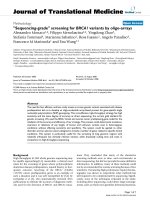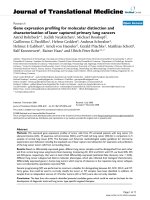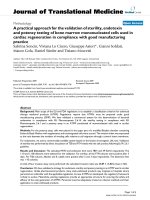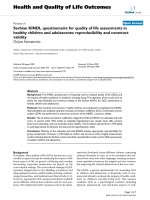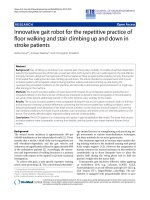Báo cáo hóa học: " Monotone iterative technique for impulsive fractional evolution equations" potx
Bạn đang xem bản rút gọn của tài liệu. Xem và tải ngay bản đầy đủ của tài liệu tại đây (319.2 KB, 12 trang )
RESEARC H Open Access
Monotone iterative technique for impulsive
fractional evolution equations
Jia Mu
*
and Yongxiang Li
* Correspondence: mujia88@163.
com
Department of Mathematics,
Northwest Normal University,
Lanzhou, Gansu 730000, People’s
Republic of China
Abstract
In this article, the well-known monotone iterative technique is extended for
impulsive fractional evolution equations. Under some monotone conditions and
noncompactness measure conditions of the nonlinearity, some existence and
uniqueness results are obtained. A generalized Gronwall inequality for fractional
differential equation is also used. As an application that illustrates the abstrac t results,
an example is given.
2000 MSC: 26A33; 34K30; 34K45.
Keywords: impulsive fractional evolution equations, existence and uniqueness,
monotone iterative technique, Gronwall inequality, noncompactness measure
1 Introduction
In this article, we use the monotone iterative technique to investigate the existence and
uniqueness of mild solutions of the impulsive fractional evolution equation in an
ordered Banach space X:
⎧
⎪
⎨
⎪
⎩
D
α
u(t )+Au(t)=f (t, u(t )), t ∈ I , t = t
k
u|
t=t
k
= I
k
(u(t
k
)), k =1,2, , m,
u(0) = x
0
∈ X,
(1:1)
where D
a
is the Caputo fractional derivative of order 0 <a <1,A: D(A) ⊂ X ® X is a
linear closed densely defined operator, - A is the infinitesimal generator of an analytic
semigroup of uniformly bou nded linear operators T(t)(t ≥ 0), I =[0,T], T >0,0=t
0
<t
1
<t
2
< <t
m
<t
m+1
= T , f: I × X ® X is continuous, I
k
: X ® X is a given continu-
ous function,
u|
t=t
k
= u(t
+
k
) − u(t
−
k
)
,where
u
(t
+
k
)
and
u
(t
−
k
)
represent the right and left
limits of u(t)att = t
k
, respectively.
Fractional-order models are found to be more adequate than integer-order models in
some real-world problems. Fractional derivatives describe the property of memory and
heredity of materials, and it is the major advantage of fractional derivatives compared
with integer-order derivatives. Fractional differential equations have recently proved to
be valuable tools in the modeling of many phenomena in various fields of science. For
instance, fractional calculus concepts have been used in the modeling of neurons [1], vis-
coe lastic materials [2]. Other examples from fractional-order dynamics can be found in
[3-7] and the references therein. A strong motivation for investigating the initial value
problem (1.1) comes from physics. For example, fractional diffusion equations are
Mu and Li Journal of Inequalities and Applications 2011, 2011:125
/>© 2011 Mu and Li; licensee Springer. This is an Open Access article distributed under the terms of the Creative Commons Attribution
License ( which permits unrestricted use, distribution, and reproduction in any medium,
provided the original work is properly cited.
abstract partial differential equations that involve fractional derivatives in space and
time. The time fractional diffusion equation is obtained from the standard diffusion
equation by replacing the first-or der time derivative with a fractional derivative of order
a Î (0, 1), namely
∂
α
t
u(y, t)=Au(y, t), t ≥ 0, y ∈ R
,
(1:2)
where A may be linear fractional partial differential operator. For fractional diffusion
equations, we can see [8-10] and the references therein.
It is well known that the method of monotone iterative technique has been proved to
be an effective and a flexible mechanism. Du and Lakshmikantham [11] established a
monotone iterative method for an initial value problem for ordinary differential equa-
tion. Later on, many articles used the monotone iterative technique to establish exis-
tence and comparison results for nonlinear problems. For evolution equations of
integer order (a = 1), Li [12-16] and Yang [17] used this method, in which positive
C
0
-semigroup play an important role.
The theory of impulsive differential equations has an extensive physical backg round
and realistic mathematical model, and hence has been emerging as an important area
of investigation in recent years, see [18]. Correspondingly, the exi stence of solutions of
impulsive fractional differential equations has also been studied by some authors, see
[19-23]. They used the contraction mapping principle, Krasnoselskii’s fixed point theo-
rem, Schauder’s fixed point theorem, Leray Schauder alternative.
To the best of the authors’ knowledge, no results yet exist for the impulsive frac-
tional evolution equations (1.1) by using the monotone iterative technique. The
appr oach via fractional differenti al inequal ities is clearly bett er suited as in the case of
classical results of differential equations and therefore this article choose to proceed in
that setup.
Our contribution in this work is to establish the monotone iterative technique for
the impulsive fractional evolution equation (1.1). Inspired by [12-17,24-27], under
some monotone conditions and noncompactness measu re conditions of nonlineari ty f,
we obtain results on the existence and uniq ueness of m ild solutions of problem (1.1).
A generalized Gronwall inequality for fractional differential equation is also applied. At
last, to illustrate our main results, we examine sufficient conditions for the main results
to an impulsive fractional partial differential diffusion equation.
2 Preliminaries
In this section, we introduce notations, definitions and preliminary facts which are
used throughout this article.
Definition 2.1. [4] The Riemann-Liouville fractional integral of order a >0withthe
lower limit zero, of function f Î L
1
(ℝ
+
), is defined as
I
α
f (t)=
1
(
α
)
t
0
(t − s)
α−1
f (s)ds
,
(2:1)
where Γ(·) is the Euler gamma function.
Definition 2.2. [4] The Caputo fractional derivative of order a > 0 with the lower
limit zero, n-1<a <n, is defined as
Mu and Li Journal of Inequalities and Applications 2011, 2011:125
/>Page 2 of 12
D
α
f (t)=
1
(
n − α
)
t
0
(t − s)
n−α−1
f
(n)
(s)ds
,
(2:2)
where the function f(t) has a bsolutely continuous derivatives up to order n-1. If 0
<a < 1, then
D
α
f (t)=
1
(
1 − α
)
t
0
f
(s)
(
t − s
)
α
ds
.
(2:3)
If f is an abstract function with values in X, then the integrals and deri vatives which
appear in (2.1) and (2.2) are taken in Bochner’s sense.
Let X be an ordered Banach space with norm || · || and partial order ≤, whose posi-
tive cone P ={y Î X | y ≥ θ}(θ is the zero element of X) is normal with normal con-
stant N.LetC(I, X) be the Banach space of all continuous X-value functions on
interval I with norm ||u||
C
= max
tÎI
||u(t)||. Then, C (I, X) is an ordered Banach space
reduced by the positive cone P
C
={u Î C (I, X)|u(t) ≥ θ, t Î I}. Let PC (I, X)={u: I
® X | u(t) is continuous at t ≠ t
k
, left continuous at t = t
k
,and
u
(t
+
k
)
exists, k =1,2,
, m}. Evident ly, PC (I, X) i s an ordered Banach space w ith norm ||u||
PC
=sup
tÎI
||u
(t)|| and the partial order ≤ reduced by the positive cone K
PC
={u Î PC (I, X)|u(t) ≥
θ, t Î I}. K
PC
is also normal with the same normal constant N.Foru, v Î PC (I, X), u
≤ v ⇔ u(t) ≤ v(t)forallt Î I . For v, w Î PC (I, X)withv ≤ w, denote the ordered
interval [v, w]={u Î PC (I, X)|v ≤ u ≤ w}inPC (I, X), and [v(t), w(t)] = {y Î X | v(t)
≤ y ≤ w(t)} (t Î I)inX.SetC
a,0
(I, X)={u Î C (I, X)|D
a
u exists and D
a
u Î C (I,
X)}. Let I ’ >= I\{t
1
, t
2
, , t
m
}. By X
1
we denote the Banach space D (A) with the graph
norm || · ||
1
= || · || + ||A · ||. An abstract function u Î PC (I, X) ∩ C
a,0
(I ’, X) ∩ C (I
’, X
1
) is called a solution of (1.1) if u(t) satisfies all the equalities of (1.1). We note that
-Ais the infinitesimal generator of a uniformly bounded analytic semigroup T(t)(t ≥
0). This means there exists M ≥ 1 such that
|
|T
(
t
)
|| ≤ M, t ≥ 0
.
(2:4)
Definition 2.3.Ifv
0
Î PC (I, X) ∩ C
a,0
(I ’, X) ∩ C (I ’, X
1
) and satisfies inequalities
⎧
⎪
⎨
⎪
⎩
D
α
v
0
(t )+Av
0
(t ) ≤ f (t, v
0
(t )), t ∈ I , t = t
k
,
v
0
|
t=t
k
≤ I
k
(v
0
(t
k
)), k =1,2, , m,
v
0
(0) ≤ x
0
,
(2:5)
then v
0
is called a lower solution of problem (1.1); if all inequalities of (2.5) are
inverse, we call it an upper solution of problem (1.1).
Lemma 2.4. [28 -30]If h satisfies a uniform Hölder condition, with exponent b Î (0,
1], then the unique solution of the linear initial value problem (LIVP)
D
α
u(t )+Au(t)=h(t), t ∈ I
,
u(0) = x
0
∈ X
(2:6)
is given by
u
(t )=U(t)x
0
+
t
0
(t − s)
α−1
V(t − s)h(s)ds
,
(2:7)
Mu and Li Journal of Inequalities and Applications 2011, 2011:125
/>Page 3 of 12
where
U( t)=
∞
0
ζ
α
(θ)T(t
α
θ)dθ, V(t)=α
∞
0
θζ
α
(θ)T(t
α
θ)dθ
,
(2:8)
ζ
α
(θ)=
1
α
θ
−1−
1
α
ρ
α
(θ
−
1
α
)
,
(2:9)
ρ
α
(θ)=
1
π
∞
n
=
0
(−1)
n−1
θ
−αn−1
(nα +1)
n!
sin(nπα), θ ∈ (0, ∞)
,
ζ
a
(θ) is a probability density function defined on (0, ∞).
Remark 2.5. [29,31-33]ζ
a
(θ) ≥ 0, θ Î (0, ∞),
∞
0
ζ
α
(θ)dθ =
1
,
∞
0
θζ
α
(θ)dθ =
1
(
1+α
)
.
Definition 2.6. By the mild solution of IVP (2.6), we mean that the function u Î C
(I, X) satisfying the integral equation
u
(t )=U(t)x
0
+
t
0
(t − s)
α−1
V(t − s)h(s)ds
,
where U(t) and V (t) are given by (2.8).
Form Definition 2.6, we can easily obtain the following result.
Lemma 2.7. For any h Î PC (I, X), y
k
Î X, k = 1, 2, , m, the LIVP
⎧
⎪
⎨
⎪
⎩
D
α
u(t )+Au(t)=h(t), t ∈ I, t = t
k
,
u|
t=t
k
= y
k
, k =1,2, , m,
u(0) = x
0
∈ X,
(2:10)
had the unique mild solution u Î PC (I, X) given by
u
(t )=
⎧
⎪
⎪
⎪
⎪
⎪
⎪
⎪
⎪
⎪
⎪
⎪
⎨
⎪
⎪
⎪
⎪
⎪
⎪
⎪
⎪
⎪
⎪
⎪
⎩
U( t)x
0
+
t
0
(t − s)
α−1
V(t − s)h(s)ds, t ∈ [0, t
1
],
U( t)[u(t
1
)+y
1
]+
t
t
1
(t − s)
α−1
V(t − s)h( s ) ds, t ∈ (t
1
, t
2
],
.
.
.
U( t)[u(t
m
)+y
m
]+
t
t
m
(t − s)
α−1
V(t − s)h( s ) ds, t ∈ (t
m
, T]
,
(2:11)
where U (t) and V (t) are given by (2.8).
Remark 2.8. We note that U (t)andV (t) do not possess the semigroup properties.
The mild solution of (2.10) can be expressed only by using piecewise functions.
Definition 2.9. An operator family S (t): X ® X (t ≥ 0) in X is called to be positive if
for any y Î P and t ≥ 0 such that S (t) y ≥ θ.
From Definition 2.9, if T (t)(t ≥ 0) is a positive semigroup generated by -A, h ≥ θ,
x
0
≥ θ and y
k
≥ θ, k = 1, 2, , m, then the mild solution u Î PC (I, X) of (2.10) satisfies
u ≥ θ. For positive semigroups, one can refer to [12-16].
Now, we recall some properties of the measure of noncompactness will be used later.
Let μ (·) denote the Kuratowski measure of noncompactness of the bounded set. For
the details of the definition and properties of the measure of noncompactness, see
Mu and Li Journal of Inequalities and Applications 2011, 2011:125
/>Page 4 of 12
[34]. For any B ⊂ C (I, X)andt Î I,setB (t)={u(t)|u Î B}. If B is bounded in C (I,
X), then B (t) is bounded in X, and μ (B(t)) ≤ (B).
Lemma 2.10. [35]Let B ={u
n
} ⊂ C (I, X)(n =1,2, )be a bounded and countable
set. Then, μ (B(t)) is Lebesgue integral on I, and
μ
I
u
n
(t ) dt|n =1,2,
≤ 2
I
μ(B(t))dt
.
In order to prove our r esults, we also need a generalized Gronwall inequality for
fractional differential equation.
Lemma 2.11.[36]Suppose b ≥ 0, b >0and a(t) is a nonnegative function locally
integrable on 0 ≤ t <T(someT≤ +∞), and suppose u (t) is nonnegative and l ocally
integrable on 0 ≤ t <T with
u
(t ) ≤ a(t)+b
t
0
(t − s)
β−1
u(s)d
s
on this interval; then
u
(t ) ≤ a(t)+
t
0
∞
n=1
(b(β))
n
(
nβ
)
(t − s)
nβ−1
a(s)
ds,0≤ t < T
.
3 Main results
Theorem 3.1. Let X be an ordered Banach space, whose positive cone P is normal with
normal constant N. Assume that T(t)(t ≥ 0) is positive, the Cauchy problem (1.1) has a
lower solution v
0
Î C (I, X) and an upper solution w
0
Î C (I, X) with v
0
≤ w
0
, and the
following conditions are satisfied:
(H
1
) There exists a constant C ≥ 0 such that
f
(
t, x
2
)
− f
(
t, x
1
)
≥−C
(
x
2
− x
1
)
for any t Î I, and v
0
(t) ≤ x
1
≤ x
2
≤ w
0
(t). That is, f (t, x)+Cx is increasing in x for
x Î [v
0
(t), w
0
(t)].
(H
2
) The impulsive function I
k
satisfies inequality
I
k
(
x
1
)
≤ I
k
(
x
2
)
, k =1,2, ,
m
for any t Î I, and v
0
(t) ≤ x
1
≤ x
2
≤ w
0
(t).Thatis, I
k
(x) is increasing in x for x Î
[v
0
(t), w
0
(t)].
(H
3
) There exists a constant L ≥ 0 such that
μ
(
{f
(
t, x
n
)
}
)
≤ Lμ
(
{x
n
}
)
for any t Î I, an increasing or decreasing monotonic sequence {x
n
} ⊂ [v
0
(t), w
0
(t)].
Then, the Cauchy problem (1.1) has the minimal and maximal mild solutions
between v
0
and w
0
, which can be obtained by a monotone iterative procedure starting
from v
0
and w
0
, respectively.
Mu and Li Journal of Inequalities and Applications 2011, 2011:125
/>Page 5 of 12
Proof.Itiseasytoseethat- (A + CI) generates an analytic semigroup S (t)=e
-Ct
T
(t), and S (t)(t ≥ 0) is positive. Let
(t)=
∞
0
ζ
α
(θ)S(t
α
θ)d
θ
,
(t)=α
∞
0
θζ
α
(θ)S(t
α
θ)d
θ
. By Remark 2.5, F (t)(t ≥ 0) and Ψ (t)(t ≥ 0) are positive.
By (2.4) and Remark 2.5, we have that
|
|(t)|| ≤ M, ||(t)|| ≤
α
(
α +1
)
M M
1
, t ≥ 0
.
(3:1)
Let D =[v
0
, w
0
],
J
1
=[t
0
, t
1
]=[0,t
1
]
,
J
k
=(t
k−1
, t
k
]
, k = 2, 3, , m +1.Wedefinea
mapping Q: D ® PC (I, X)by
Qu(t)=
⎧
⎪
⎪
⎪
⎪
⎪
⎪
⎪
⎪
⎪
⎪
⎪
⎪
⎪
⎪
⎪
⎪
⎪
⎨
⎪
⎪
⎪
⎪
⎪
⎪
⎪
⎪
⎪
⎪
⎪
⎪
⎪
⎪
⎪
⎪
⎪
⎩
(t)x
0
+
t
0
(t − s)
α−1
(t − s)[f (s, u(s)) + Cu(s)]ds, t ∈ J
1
,
(t)[u(t
1
)+I
1
(u(t
1
))] +
t
t
1
(t − s)
α−1
(t − s)[f (s, u(s)) + Cu(s)]ds,
t ∈ J
2
,
.
.
.
(t)[u(t
m
)+I
m
(u(t
m
))] +
t
t
m
(t − s)
α−1
(t − s)[f (s, u(s)) + Cu(s)]ds
,
t ∈ J
m+1
.
(3:2)
Clearly, Q: D ® PC (I, X) is continuous. By Lemma 2.7, u Î D is a mild solution of
problem (1.1) if and only if
u
=
Q
u.
(3:3)
For u
1
, u
2
Î D and u
1
≤ u
2
, from the positivity of operators F (t)andΨ (t), (H
1
),
(H
2
), we have inequality
Q
u
1
≤
Q
u
2
.
(3:4)
Now, we show that v
0
≤ Qv
0
, Qw
0
≤ w
0
.LetD
a
v
0
(t)+Av
0
(t)+Cv
0
(t) ≜ s (t). By
Definition 2.3, Lemma 2.7, the positivity of operators F (t)andΨ (t), for
t ∈ J
1
,we
have that
v
0
(t )=(t)v
0
(0) +
t
0
(t − s)
α−1
(t − s)σ (s)ds
≤ (t)x
0
+
t
0
(t − s)
α−1
(t − s)[f (s, v
0
(s)) + Cv
0
(s)]ds
.
For
t ∈ J
2
, we have that
v
0
(t)=(t)[v
0
(t
1
)+v
0
|
t=t
1
]+
t
t
1
(t − s)
α−1
(t − s)σ (s)ds
≤ (t)[v
0
(t
1
)+I
1
(v
0
(t
1
))] +
t
t
1
(t − s)
α−1
(t − s)[f (s, v
0
(s)) + Cv
0
(s)]ds
.
Continuing such a process interval by interval to
J
m
+
1
,by(3.2),weobtainthatv
0
≤
Qv
0
.
Mu and Li Journal of Inequalities and Applications 2011, 2011:125
/>Page 6 of 12
Similarly, we can show that Qw
0
≤ w
0
. For u Î D, in view of (3.4), then v
0
≤ Qv
0
≤
Qu ≤ Qw
0
≤ w
0
. Thus, Q: D ® D is an increasing monotonic operator. We can now
define the sequences
v
n
=
Q
v
n−1
, w
n
=
Q
w
n−1
, n =1,2,
,
(3:5)
and it follows from (3.4) that
v
0
≤ v
1
≤ ···v
n
≤ ···≤ w
n
≤ ···≤ w
1
≤ w
0
.
(3:6)
Let B ={v
n
}(n = 1, 2, ) and B
0
={v
n-1
}(n = 1, 2, ). By (3.6) and the normality of
the positive cone P,thenB and B
0
are bounded. It follows from B
0
= B ∪ {v
0
}thatμ
(B(t)) = μ (B
0
(t)) for t Î I. Let
ϕ
(
t
)
= μ
(
B
(
t
))
= μ
(
B
0
(
t
))
, t ∈ I
.
(3:7)
From (H
3
), (3.1), (3.2), (3.5), (3.7), Lemma 2.10 and the positivity of operator Ψ ( t),
for
t ∈ J
1
, we have that
ϕ(t)=μ(B(t)) = μ(QB
0
(t ))
= μ
t
0
(t − s)
α−1
(t − s)[f (s, v
n−1
(s)) + Cv
n−1
(s)]ds|n =1,2,
≤ 2
t
0
μ({(t − s)
α−1
(t − s)[f (s, v
n−1
(s)+Cv
n−1
(s)]n =1,2, })ds
≤ 2M
1
t
0
(t − s)
α−1
(L + C)μ(B
0
(s))ds
=2M
1
(L + C)
t
0
(t − s)
α−1
ϕ(s)ds.
(3:8)
By (3.8) and Lemma 2.11, we obtain that (t) ≡ 0on
J
1
. In pa rticu lar, μ (B (t
1
)) = μ
(B
0
(t
1
)) = (t
1
) = 0. This means that B (t
1
)andB
0
(t
1
)) are precompact in X.Thus,I
1
(B
0
(t
1
)) is pre-compact in X and μ(I
1
(B
0
(t
1
))) = 0. For
t ∈ J
2
,usingthesameargu-
ment as above for
t ∈ J
1
,
we have that
ϕ(t)=μ(B(t)) = μ(QB
0
(t ))
= μ
(t)[v
n−1
(t
1
)+I
1
(v
n−1
(t
1
))]
+
t
t
1
(t − s)
α−1
(t − s)[f (s, v
n−1
(s)) + Cv
n−1
(s)]ds|n =1,2,
≤ M[μ(B
0
(t
1
)) + μ(I
1
(B
0
(t
1
)))] + 2M
1
(L + C)
t
t
1
(t − s)
α−1
ϕ(s)ds
=2M
1
(L + C)
t
t
1
(t − s)
α−1
ϕ(s)ds.
(3:9)
By (3.9) and Lemma 2.11, (t) ≡ 0on
J
2
. Then, μ (B
0
(t
2
)) = μ (I
1
(B
0
(t
2
))) = 0. Conti-
nuing such a process interval by interval to
J
m
+
1
, we can prove that (t) ≡ 0onevery
J
k
, k =1,2, , m +
1
. This means {v
n
(t)} (n = 1, 2, ) is precompact in X for every t Î
I.So,{v
n
(t)} has a convergent subsequence in X. In view of (3.6), we can easily prov e
that {v
n
(t)} itself is conver gent in X. That i s, there exist u(t) Î X such that v
n
(t) ® u
(t)asn ® ∞ for every t Î I. By (3.2) and (3.5), we have that
Mu and Li Journal of Inequalities and Applications 2011, 2011:125
/>Page 7 of 12
v
n
(t )=
⎧
⎪
⎪
⎪
⎪
⎪
⎪
⎪
⎪
⎪
⎪
⎪
⎪
⎪
⎪
⎪
⎪
⎪
⎪
⎪
⎨
⎪
⎪
⎪
⎪
⎪
⎪
⎪
⎪
⎪
⎪
⎪
⎪
⎪
⎪
⎪
⎪
⎪
⎪
⎪
⎩
(
t
)
x
0
+
t
0
(t − s)
α−1
(t − s)[f (s, v
n−1
(s)) + Cv
n−1
(s)]ds, t ∈ J
1
,
(t)[v
n−1
(t
1
)+I
1
(v
n−1
(t
1
))]
+
t
t
1
(t − s)
α−1
(t − s)[f (s, v
n−1
(s)) + Cv
n−1
(s)]ds, t ∈ J
2
,
.
.
.
(t)[v
n−1
(t
m
)+I
m
(v
n−1
(t
m
))]
+
t
t
m
(t − s)
α−1
(t − s)[f (s, v
n−1
(s)) + Cv
n−1
(s)]ds, t ∈ J
m+1
.
Let n ® ∞, then by Lebesgue-dominated convergence theorem, we have that
u
−
(t )=
⎧
⎪
⎪
⎪
⎪
⎪
⎪
⎪
⎪
⎪
⎪
⎪
⎪
⎪
⎪
⎪
⎪
⎪
⎪
⎨
⎪
⎪
⎪
⎪
⎪
⎪
⎪
⎪
⎪
⎪
⎪
⎪
⎪
⎪
⎪
⎪
⎪
⎪
⎩
(t)x
0
+
t
0
(t − s)
α−1
(t − s)[f (s, u
−
(s)) + Cu
−
(s)]ds, t ∈ J
1
,
(t)[u
−
(t
1
)+I
1
(u
−
(t
1
))]
+
t
t
1
(t − s)
α−1
(t − s)[f (s, u
−
(s)) + Cu
−
(s)]ds, t ∈ J
2
,
.
.
.
(t)[u
−
(t
m
)+I
m
(u
−
(t
m
))]
+
t
t
m
(t − s)
α−1
(t − s)[f (s, u
−
(s)) + Cu
−
(s)]ds, t ∈ J
m+1
,
and uÎ C (I, X). Then, u= Qu. Similarly, we can prove that there exists ū Î C(I,X)
such that ū = Qū. By (3.4), if u Î D, and u is a fixed point of Q, then v
1
= Qv
0
≤ Qu =
u ≤ Qw
0
= w
1
.Byinduction,v
n
≤ u ≤ w
n
. By (3.6) and taking the limit as n ® ∞,we
conclude that v
0
≤ u≤ u ≤ ū ≤ w
0
. That means that u, ū are the minimal and maximal
fixed points of Q on [v
0
, w
0
], respectively. By (3.3), they are the minimal and maximal
mild solutions of the Cauchy problem (1.1) on [v
0
, w
0
], respectively. □
Remark 3.2. Theorem 3.1 extend [[37], Theorem 2.1]. Even if X = ℝ, A = 0 and I
k
=
0, k = 1, 2, , m, our results are also new.
Corollary 3.3. Let X be an ordered Banach space, whose positive cone P is regular.
Assume that T(t)(t ≥ 0) is positive, the Cauchy problem (1.1) has a lower solution v
0
Î
C (I, X) andanuppersolutionw
0
Î C (I, X) with v
0
≤ w
0
,(H
1
) and (H
2
) hold. Then,
the Cauchy problem (1.1) has the minimal and maximal mild solutions between v
0
and
w
0
, which can be obtained by a monotone iterative procedure starting from v
0
and w
0
,
respectively.
Proof.Since(H
1
)and(H
2
) are satisfied, then (3.6) holds. In regular positive cone P,
any monotonic and ordered-bou nded sequ ence is convergent. For t Î I, let {x
n
}bean
increasing or decreasing sequence in [v
0
(t), w
0
( t)]. By (H
1
), {f (t, x
n
)+Cx
n
}isan
ordered-monotonic and ordered-bounded sequence in X. Then, μ {f (t, x
n
)+Cx
n
}=μ
({x
n
}) = 0. By the properties of the measure of noncompactness, we have
μ
(
{f
(
t, x
n
)
}
)
≤ μ
(
{f
(
t, x
n
)
+ Cx
n
}
)
+ Cμ
(
{x
n
}
)
=0
.
(3:10)
So, ( H
3
) holds. Then, by the proof of Theorem 3.1, the proof is then complete. □
Mu and Li Journal of Inequalities and Applications 2011, 2011:125
/>Page 8 of 12
Coroll ary 3.4. Let X be an ordered and weakly sequentially complete Banach sp ace,
whose positive cone P is normal with normal constant N. Assume that T(t)(t ≥ 0) is
positive, the Cauchy problem (1.1) has a lower solution v
0
Î C (I, X) andanupper
solution w
0
Î C (I, X) with v
0
≥ w
0
,(H
1
) and (H
2
) hold. Then, the Cauchy problem
(1.1) has the minimal and maximal mild solutions between v
0
and w
0
, which can be
obtained by a monotone iterative procedure starting from v
0
and w
0
, respectively.
Proof. Since X is an ordered and weakly sequentially complete Banach space, then the
assumption (H
3
) holds. In fact, by [[38] , Theorem 2.2], any monotonic and ordered-
bounded sequence is precompact. Let x
n
be an increasing or decreasing sequence. By
( H
1
), {f (t, x
n
)+Cx
n
} is a monotonic and ordered-bounded sequence. Then, by the
properties of the measure of noncompactness, we have
μ
(
{f
(
t, x
n
)
}
)
≤ μ
(
{f
(
t, x
n
)
+ Cx
n
}
)
+ μ
(
{Cx
n
}
)
=0
.
So, ( H
3
) holds. By Theorem 3.1, the proof is then complete. □
Theorem 3.5. Let X be an ordered Banach space, whose positive cone P is normal
with normal constant N. Assum e that T(t)(t ≥ 0) is positive, the Cauchy problem (1.1)
has a lower solution v
0
Î C (I, X) andanuppersolutionw
0
Î C (I, X) with v
0
≤ w
0
,
(H
1
) and (H
2
) hold, and the following condition is satisfied:
(H
4
) There is a constant S ≥ 0 such that
f
(
t, x
2
)
− f
(
t, x
1
)
≤ S
(
x
2
− x
1
)
for any t Î I, v
0
(t) ≤ x
1
≤ x
2
≤ w
0
(t).
Then, the Cauchy problem (1.1) has the unique mild solution between v
0
and w
0
,
which can be obtained by a monotone iterative procedure starting from v
0
or w
0
.
Proof. We can find that (H
1
), (H
2
)and(H
4
) imply (H
3
). In fact, for t Î I,let{x
n
} ⊂
[v
0
(t), w
0
(t)] be an increasing sequence. For m, n =1,2, withm >n,by(H
1
)and
(H
4
), we have that
θ ≤ f
(
t, x
m
)
− f
(
t, x
n
)
+ C
(
x
m
− x
n
)
≤
(
S + C
)(
x
m
− x
n
).
(3:11)
By (3.11) and the normality of positive cone P, we have
|
|f
(
t, x
m
)
− f
(
t, x
n
)
|| ≤
(
NS + NC + C
)
||x
m
− x
n
||
.
(3:12)
From (3.12) and the definition of the measure of noncompactness, we have that
μ
(
{f
(
t, x
n
)
}
)
≤ Lμ
(
{x
n
}
),
where L = NS + NC + C. Hence, (H
3
) holds.
Therefore, by Theorem 3.1, the Cauchy problem (1.1) has the minimal mild solution
u and the maximal mild solut ion ū on D =[v
0
, w
0
]. In view of the proof of Theorem
3.1, we show that u = ū. For
t ∈ J
1
, by (3.2), (3.3), (H
4
) and the positivity of operator Ψ
(t), we have that
θ ≤
¯
u(t ) − u
−
(t )=Q
¯
u(t ) − Qu
−
(t )
=
t
0
(t − s)
α−1
(t − s)[f (s,
¯
u(s)) − f(s, u
−
(s)) + C(
¯
u(s) − u
−
(s))]d
s
≤
t
0
(t − s)
α−1
(t − s)(S + C)(
¯
u(s) − u
−
(s))ds.
(3:13)
Mu and Li Journal of Inequalities and Applications 2011, 2011:125
/>Page 9 of 12
By (3.1), (3.13) and the normality of the positive cone P, we obtain that
|
|
¯
u(t ) − u
−
(t ) || ≤ NM
1
(S + C)
t
0
(t − s)
α−1
||
¯
u(s) − u
−
(s)||ds
.
By Lemma 2.11, then u(t) ≡ ū(t)on
J
1
. For
t ∈ J
2
,sinceI
1
(ū(t
1
)) = I
1
(u(t
1
)), using the
same argument as above for
t ∈ J
1
, we can prove that
|
|
¯
u(t ) − u
−
(t ) || ≤ NM
1
(S + C)
t
t
1
(t − s)
α−1
||
¯
u(s) − u
−
(s)||ds
.
Again, by Lemma 2.11, we obtain that u( t) ≡ ū(t)on
J
2
. Continuing such a process
interval up to
J
m
+
1
, we see that u(t) ≡ ū(t)overthewholeofI. Hence, u= ū is the
unique mild solution of the Cauchy problem (1.1) on [v
0
, w
0
]. By the proof of Theorem
3.1, we know it can be obtained by a monotone iterative procedure starting from v
0
or
w
0
. □
4 Examples
Example 4.1. In order to illustrate our main results, we consider the impulsive frac-
tional partial differential diffusion equation in X
⎧
⎪
⎪
⎪
⎨
⎪
⎪
⎪
⎩
∂
α
t
u −∇
2
u = g(y, t, u), (y, t) ∈ × I, t = t
k
,
u|
t=t
k
= J
k
(y, u(y, t
k
)), k =1,2, , m,
u|
∂
=0,
u
(
y,0
)
= ψ
(
y
)
,
(4:1)
where
∂
α
t
is the Caputo fractional partial derivative of order 0 <a <1,∇
2
is the
Laplace operator, I =[0,T], Ω ⊂ ℝ
N
is a bounded domain with a sufficiently smooth
boundary ∂Ω,
g
:
¯
× I × R →
R
is continuous,
J
k
:
¯
× R →
R
is also con tinuous, k =
1, 2, , m.
Let X = L
2
(Ω), P ={v|vÎ L
2
(Ω), v (y) ≥ 0 a.e.y Î Ω}. Then, X is a Banach space,
and P is a normal cone in X. Define the operator A as follows:
D(A)=H
2
() ∩ H
1
0
(), Au = −∇
2
u
.
Then, -Agenerate an analytic semigroup of uniformly bounded analytic semigroup
T(t)(t ≥ 0) in X (see [29]). T (t)(t ≥ 0) is positive (see [15,16,39,40]). Let u (t)=u(·, t),
f (t, u (t)) = g (·, t, u (·, t)), I
k
(u (t
k
)) = J
k
(·, u (·, t
k
)), then the problem (4.1) can be
transformed into the following problem:
⎧
⎨
⎩
D
α
u(t )+Au(t)=f (t, u(t)), t ∈ I, t = t
k
,
u|
t=t
k
= I
k
(u(t
k
)), k =1,2, , m,
u(0) = ψ.
(4:2)
Let l
1
be the first eigenvalue of A, ψ
1
is the corresponding eigenfunction. Then, l
1
≥
0, ψ
1
(y) ≥ 0. In order to so lve the problem (4.1), we also need the following
assumptions:
(O
1
)
ψ(y) ∈ H
2
() ∩ H
1
0
(
)
,0≤ ψ(y) ≤ ψ
1
(y), g(y, t,0)≥ 0, g(y, t, ψ
1
(y)) ≤ l
1
ψ
1
(y), J
k
(y,0) ≥ 0, J
k
(y,ψ
1
(y)) ≤ 0, k = 1,2, , m.
(O
2
)Foranyu
1
and u
2
in any bounded and ordered interval, and u
1
≤ u
2
,wehave
inequality
Mu and Li Journal of Inequalities and Applications 2011, 2011:125
/>Page 10 of 12
J
k
(
y, u
1
(
y, t
k
))
≤ J
k
(
y, u
2
(
y, t
k
))
, y ∈ , k =1,2, , m
.
(O
3
) The partial derivative
g
u
(y, t, u
)
is continuous on any bounded domain.
Theorem 4.2.IfO
1
,O
2
and O
3
are satisfied, then the problem (4.1) has the unique
mild solution.
Proof. From Definition 2.3 and O
1
, we obtain that 0 is a lower solution of (4.2), and
ψ
1
(y) is an upper solution of (4.2). Form O
2
and O
3
, it is easy to verify that (H
1
), (H
2
)
and (H
4
) are satisfied. Therefore, by Theorem 3.5, the problem (4.1) has the unique
mild solution. □
Acknowledgements
This research was supported by the NNSFs of China (10871160, 11061031) and Project of NWNU-KJCXGC-3-47.
Authors’ contributions
JM carried out the main part of this article. All authors read and approved the final manuscript.
Competing interests
The authors declare that they have no competing interests.
Received: 24 June 2011 Accepted: 30 November 2011 Published: 30 November 2011
References
1. Lundstrom, B, Higgs, M, Spain, W, Fairhall, A: Fractional differentiation by neocortical pyramidal neurons. Nat Neurosci.
11, 1335–1342 (2008). doi:10.1038/nn.2212
2. Rossikhin, Y, Shitikova, M: Application of fractional derivatives to the analysis of damped vibrations of viscoelastic single
mass system. Acta Mech. 120, 109–125 (1997). doi:10.1007/BF01174319
3. Hilfer, R: Applications of Fractional Calculus in Physics. World Scientific, Singapore (2000)
4. Kilbas, A, Srivastava, H, Trujillo, J: Theory and Applications of Fractional Differential Equations. Elsevier, Amsterdam (2006)
5. Miller, K, Ross, B: An Introduction to the Fractional Calculus and Fractional Differential Equations. Wiley, New York (1993)
6. Podlubny, I: Fractional Differential Equations. In Math Sci Eng, vol. 198,Academic Press, San Diego (1999)
7. Samko, S, Kilbas, A, Marichev, O: Fractional Integrals and Derivatives: Theory and Applications. Gordon and Breach
Science, Switzerland (1993)
8. Baeumer, B, Kurita, S, Meerschaert, M: Inhomogeneous fractional diffusion equations. J Frac Appl Anal. 8, 375–397 (2005)
9. Henderson, J, Ouahab, A: Fractional functional differential inclusions with finite delay. Nonlinear Anal. 70, 2091–2105
(2009). doi:10.1016/j.na.2008.02.111
10. Meerschaert, M, Benson, D, Scheffler, H, Baeumer, B: Stochastic solution of space-time fractional diffusion equations.
Phys Rev E. 65, 1103–1106 (2002)
11. Du, S, Lakshmikantham, V: Monotone iterative technique for differential equations in Banach spaces. J Anal Math Anal.
87, 454–459 (1982). doi:10.1016/0022-247X(82)90134-2
12. Li, Y: Existence and uniqueness of positive periodic solutions for abstract semilinear evolution equations. J Syst Sci Math
Sci. 25(6),720–728 (2005)
13. Li, Y: Existence of solutions to initial value problems for abstract semilinear evolution equations. Acta Math Sin.
48(6),1089–1094 (2005)
14. Li, Y: Periodic solutions of semilinear evolution equations in Banach spaces. Acta Math Sin. 41(3),629–636 (1998)
15. Li, Y: The global solutions of initial value problems for abstract semilinear evolution equations. Acta Anal Funct Appl.
3(4),339–347 (2001)
16. Li, Y: The positive solutions of abstract semilinear evolution equations and their applications. Acta Math Sin.
39(5),666–672 (1996)
17. Yang, H: Monotone iterative technique for the initial value problems of impulsive evolution equations in ordered
Banach spaces. Abstr Appl Anal 2010, 11 (2010). (Article ID 481648)
18. Lakshmikantham, V, Bainov, D, Simeonov, P: Theory of Impulsive Differential Equations. World Scientific, Singapore
(1989)
19. Mophou, G: Existence and uniqueness of mild solutions to impulsive fractional differential equations. Nonlinear Anal.
72, 1604–1615 (2010). doi:10.1016/j.na.2009.08.046
20. Rashid, M, Al-Omari, A: Local and global existence of mild solutions for impulsive fractional semilinear integro-
differential equation. Commun Nonlinear Sci Numer Simul. 16, 3493–3503 (2011). doi:10.1016/j.cnsns.2010.12.043
21. Shu, X, Lai, Y, Chen, Y: The existence of mild solutions for impulsive fractional partial differential equations. Nonlinear
Anal. 74, 2003–2011 (2011). doi:10.1016/j.na.2010.11.007
22. Tai, Z, Wang, X: Controllability of fractional-order impulsive neutral functional infinite delay integrodifferential systems in
Banach spaces. Appl Math Lett. 22, 1760–1765 (2009). doi:10.1016/j.aml.2009.06.017
23. Zhang, X, Huang, X, Liu, Z: The existence and uniqueness of mild solutions for impulsive fractional equations with
nonlocal conditions and infinite delay. Nonlinear Anal Hybrid Syst. 4, 775–781 (2010). doi:10.1016/j.nahs.2010.05.007
24. Li, Y, Liu, Z: Monotone iterative technique for addressing impulsive integro-differential equations in Banach spaces.
Nonlinear Anal. 66
,83–92
(2007). doi:10.1016/j.na.2005.11.013
25. Yang, H: Mixed monotone iterative technique for abstract impulsive evolution equations in Banach space. J Inequal
Appl 2010, 15 (2010). (Article ID 293410)
Mu and Li Journal of Inequalities and Applications 2011, 2011:125
/>Page 11 of 12
26. Chen, P, Li, Y: Mixed monotone iterative technique for a class of semilinear impulsive evolution equations in Banach
spaces. Nonlinear Anal. 74, 3578–3588 (2011). doi:10.1016/j.na.2011.02.041
27. Chen, P: Mixed monotone iterative technique for impulsive periodic boundary value problems in Banach spaces. Bound
Value Problem 2011, 13 (2011). (Article ID 421261). doi:10.1186/1687-2770-2011-13
28. El-Borai, M: Some probability densities and fundamental solutions of fractional evolution equations. Chaos Soliton Fract.
14, 433–440 (2002). doi:10.1016/S0960-0779(01)00208-9
29. Wang, J, Zhou, Y, Wei, W: A class of fractional delay nonlinear integrodifferential controlled systems in Banach spaces.
Commun Nonlinear Sci Numer Simul. 16, 4049–4059 (2011). doi:10.1016/j.cnsns.2011.02.003
30. Zhou, Y, Jiao, F: Nonlocal Cauchy problem for fractional evolution equations. Nonlinear Anal Real World Appl. 11,
4465–4475 (2010). doi:10.1016/j.nonrwa.2010.05.029
31. Wang, J, Zhou, Y: A class of fractional evolution equations and optimal controls. Nonlinear Anal. 12, 262–272 (2011).
doi:10.1016/j.nonrwa.2010.06.013
32. Wang, J, Zhou, Y, Wei, W, Xu, H: Nonlocal problems for fractional integrodifferential equations via fractional operators
and optimal controls. Comput Math Appl. 62, 1427–1441 (2011). doi:10.1016/j.camwa.2011.02.040
33. Zhou, Y, Jiao, F: Existence of mild solutions for fractional neutral evolution equations. Comput Math Appl. 59,
1063–1077 (2010)
34. Deimling, K: Nonlinear Functional Analysis. Springer, Berlin (1985)
35. Heinz, H: On the behaviour of measure of noncompactness with respect to differentiation and integration of vector-
valued functions. Nonlinear Anal. 7, 1351–1371 (1983). doi:10.1016/0362-546X(83)90006-8
36. Ye, H, Gao, J, Ding, Y: A generalized Gronwall inequality and its application to a fractional differential equation. J Math
Anal Appl. 328, 1075–1081 (2007). doi:10.1016/j.jmaa.2006.05.061
37. Lv, Z, Liang, J, Xiao, T: Solutions to the Cauchy problem for differential equations in Banach spaces with fractional
order. Comput Math Appl. 62, 1303–1311 (2011). doi:10.1016/j.camwa.2011.04.027
38. Du, Y: Fixed points of increasing operators in ordered Banach spaces and applications. Appl Anal. 38,1–20 (1990).
doi:10.1080/00036819008839957
39. Liang, J, Liu, J, Xiao, T: Nonlocal problems for integrodifferential equations. Dyn Contin Discrete Impuls Syst Ser (A). 15,
815–824 (2008)
40. Campanto, S: Generation of analytic semigroups by elliptic operators of second order in Hölder space. Ann Sc Norm
Sup Pisa Cl Sci. 8, 495–512 (1981)
doi:10.1186/1029-242X-2011-125
Cite this article as: Mu and Li: Monotone iterative technique for impulsive fractional evolution equations. Journal
of Inequalities and Applications 2011 2011:125.
Submit your manuscript to a
journal and benefi t from:
7 Convenient online submission
7 Rigorous peer review
7 Immediate publication on acceptance
7 Open access: articles freely available online
7 High visibility within the fi eld
7 Retaining the copyright to your article
Submit your next manuscript at 7 springeropen.com
Mu and Li Journal of Inequalities and Applications 2011, 2011:125
/>Page 12 of 12

